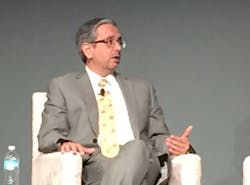Embedded in all the talk about the Industrial Internet of Things, Smart Manufacturing, and Industry 4.0 are Big Data and associated analytics. Why? Because all the business-improvement insights promised by these future-of-manufacturing concepts rely on intelligence derived from analysis of mass amounts of data. So it makes sense that during Rockwell Automation Fair 2015 some time was devoted to exploring the realities of Big Data today. This discussion was presented via a panel discussion hosted by Sujeet Chand, Rockwell Automation’s senior vice president and CTO, and featuring: Francisco Castillo, CIO of Maynilad Water Services Inc.; Rick Schneider, president and CEO of Fanuc America Corp.; Wayne Roller, Engineering Director at 3M; Matthias Altendorf, CEO of Endress + Hauser; and Blake Moret, senior vice president of Control Products & Solutions for Rockwell Automation.
Right from the start of the panel, Chand zeroed the discussion in on the spot where the rubber is really hitting the road today for analytics—maintenance.
“The killer app for real time analytics today is around reducing unplanned downtime,” said Moret. “That drives the rate of return faster than anything else.”
Underscoring Moret’s comment, Chand added that unplanned downtime commonly costs 15 times more than planned downtime.
Providing an end user’s perspective, Castillo pointed out several areas where Maynilad Water Services has been using data analysis over the past two years to save money for the company. “Water is a highly regulated industry,” he said, “so cost management is the name of the game for us.”
Some of the projects Castillo noted where data collection and analysis has made a major a difference include:
- Upgrading the company’s leak management system to use data from different IT and OT (operations technology) sources. “We are combining data from field devices, GIS (geographic information system), and even billing to detect where leaks are most likely present,” he said. “This is a big deal for us since our assets are underground and can't be easily seen.”
- Capturing operational data in a plant so that a manager can be notified of a failure before it occurs.
- Using hydraulic modeling to track pressures and flows across the network to see how system expansion in an area could affect delivery of water in that area.
- Using data to manage pressure through the network in a way that cannot be done with traditional PIDs. “Reviewing captured data helped us develop our own algorithm for this,” he said.
Fanuc Americas’ Schneider said, “Our journey [with Big Data analysis] has been like a slingshot being launched” due to an issue with unplanned downtimes at a major automotive industry customer. “We didn’t start with a business case; we had a major problem to solve for customer.”
Schneider says Fanuc began by looking at the highest risk machines at the customer site and extracting all the data it could out of those machines. “At first it didn’t work,” Schneider said, noting that they were still having problems identifying the cause. But as more investigation into the data took place, Fanuc was able to “find specific issues and develop algorithms to track them. Since then we have been very successful in analyzing root causes” he said.
According to Schneider, the automotive customer has since saved more than $30 million through the newfound, data analysis-driven ability to catch more 25 instances before they created production problems.
What Fanuc learned from this project has had a significant impact on the company. “This completely changes our go-to-market business model,” said Schneider. “Historically, we had little insight into how robots were being used once they were installed. Now that we get feedback every 90 seconds, we can be very proactive with customers to optimize their use of the robots and even improve energy consumption.”
Though 3M has been “collecting data for years,” said Roller, “we found ourselves chasing blips in a curve that weren’t giving us the information we needed. We slowly got better at it, but realized that, without a model-based understanding of our processes, we were chasing a lot of ghosts” due to issues like unclean data. “With a model-based approach, we were able to understand what our processes should deliver and predict what the outcome should look like and, if that did not happen, then we could look at problem areas causing the discrepancy.”
Given the increasing number of examples, such as those detailed above, that illustrate the business advantage of Big Data analytics, what advice did the panelists recommend as the best way to begin implementing analytics?
Castillo said that they learned that they didn't really “need Big Data” in the truest sense of the term. “There are lots of data coming in, but much of it is repetitive, so we can compress it. But to do this effectively, you need good analysis, and that means you need domain expertise” to make sense of what data is most important.
Endress + Hauser’s Altendorf added, “Data does not replace the cognitive capabilities of a human being, but it can help you recognize patterns” once you know what to look for.
Leaders relevant to this article:


